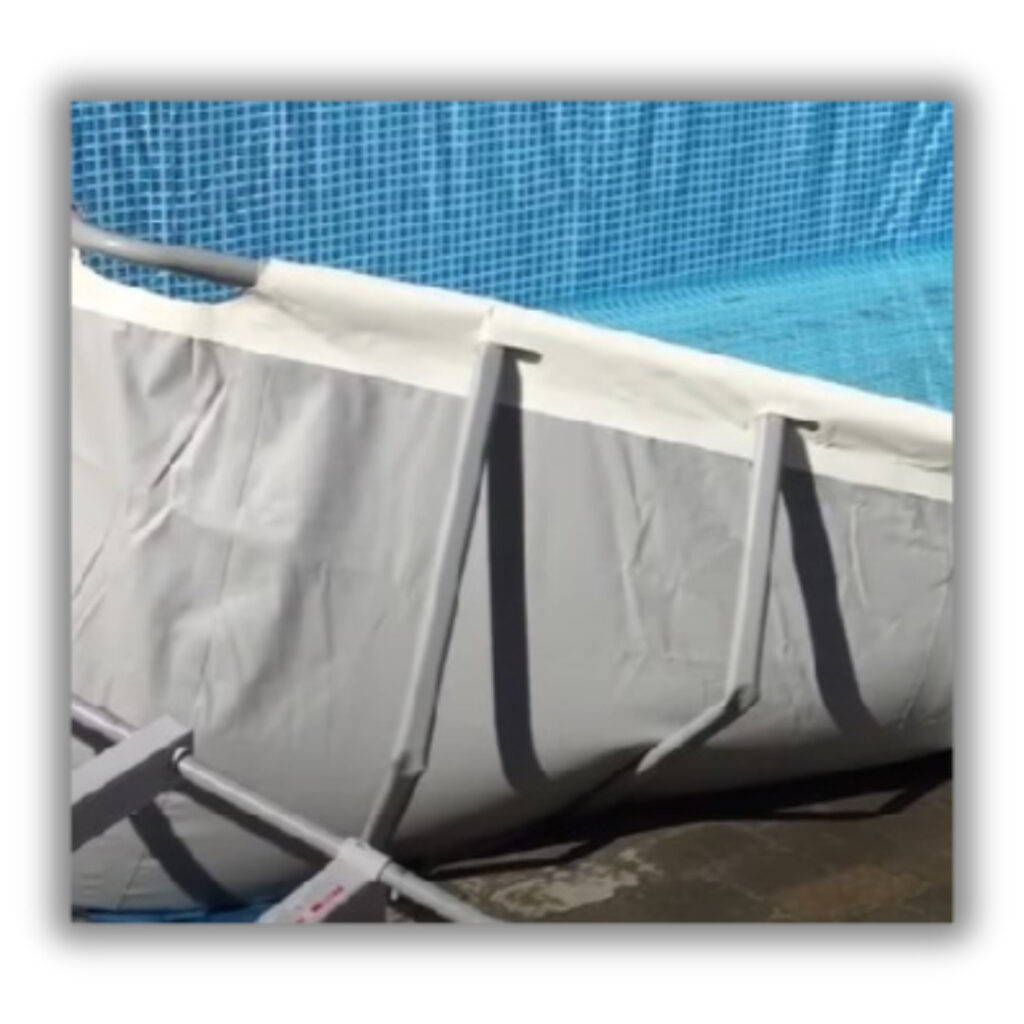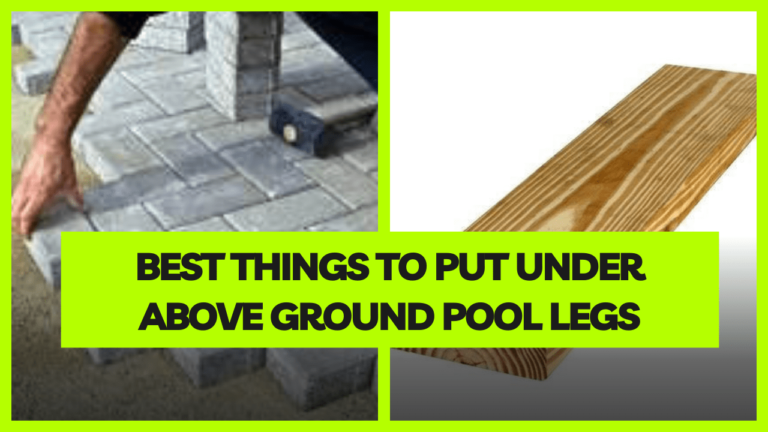If you are here then you might be facing a problem that your intex pool legs are sinking into the ground and you are looking for the right solution. Here I’m gonna share some best things to put under above ground pool legs.
Intex pools sometimes become stressful to set up because of not having a proper and solid surface to set up. But there are many solutions for this issue like putting some strong material under above ground pool legs.
In this article i am sharing some experience which i faced during the installation of intex pool. Also share some important tips that help you alot.
If you are confused what to put under pool legs we coverd in this article , So sit back, grab your coffee and let’s dive into it.
Why should we place them under the pool legs?
After some time in the new pool, due to the non-solidity of the ground and repeated water falling on it, the ground of the leg of the pool does not remain solid and the leg of the pool starts sinking into the ground, due to which the pool can be damaged in many ways. for deeply details you can visit our post which is about Intex Pool Legs Not Straight


Best things to put under above ground pool legs.
In my opinion Thick pavers are the best thing to put under above ground pool legs. Pavers are made from a mixture of cements, sand and aggregates. That provides a hard surface helps to level out your pool and prevent sinking . it equally distributes the weight of the pool by providing extra support for the pool legs.
This can also help to protect the pool liner layer from rubbing. If your pool legs are not sinking too much you can also use pavers alternatives like wooden blocks, bricks or foam pads but remember that these alternatives come with some pros and cons.
Thick Pavers/Trailer Pads (Best & Effective)
Pavers are also known as Trailer pads . These Trailer pads are manufactured for the use under the trailer wheels. These pads easily handle tons of weight and can be handled any season.
These pavers are a little bit abrasive so I would prefer to add another layer on the top of the pavers. You can use a camping mat or Gorilla pad.
Keep in mind that the paver should always be used on level ground. If the area of your pool is not level, then first level it.
Wooden Blocks/Planks (Second Favorite)
Pressure treated wood blocks are the second best things to put under above ground pool legs. Pressure treated wood blocks were earlier used under the train tracks and they could easily handle the weight of the train. Similarly, it will easily bear the weight of the pool.
Here you need to pay attention to the size and thickness of the pressure wood block. The work should be 4 inches thick and 1 foot long and wide.
The most important is the quality of the wood, if you use such types of wood that become softer after some time, such as cedar and pine wood, all these types of wood will not support your pool. Instead, you should use harder wood such as mahogany and teak, all of which are very strong and long-lasting.
Bricks
You must have seen many videos on youtube where you will find videos using bricks. This method is suitable for temporary use but if you want to live without any problem for a long time then use pavers only because the bricks start breaking after some time due to the weight of the pool.
If you use sealed bricks then it will be better as they are strong and weatherproof and can last even in summer without any issue.
Sand
If you have kids in your home who tend to spill water while taking a dip in the pool, then the sand pad is not for you as it absorbs moisture which can cause fungal, bacterial and algae to grow on the bottom of your pool legs and make your pool leg base weaker.
If you live in a rainy area, you should avoid using sand at all as there is a chance that the sand will slowly wash away from the bottom of the pool leg with the flow of water. Some people use gravel too, but that can put a hole in your pool.
I don’t advise anyone to use sand under the pool leg, yes you can definitely use it on top of the pavers as an extra layer to get additional cushions.
Foam Pads (If You’re on Concrete)
If your pool is already on a concrete surface you don’t need any kind of pavers, wood blocks and sand, but you want to make sure for stability you can use foam pads underneath your pool legs.
These pads are made for providing extra cushioning to your pool and prevent your pool from any scratches.
How to Place Concrete Pavers or Wood Under Your Pool Legs ?
If you want to install pavers or any wood under pool legs i would suggest you should contact your know professional guy who is expert in installing pavers under pool legs.
However I’m gonna share with you some important Methods that help you to install easily and at the end you will feel like a pro. Just remember that you have to make sure that your pool is level. I also share some steps that help you to level the pool.
If the Pool is Level
If your pool is in level you have an advantage that you don’t need to dig into ground. Just place the pavers underneath pool legs.
- Method 1
This method is only for those people who have not yet installed their pool. The first thing they have to do is guess where the leg of their pool will be and slightly dig down. If you find any hole fill it with some concrete or gravel then place Pavers or Wooden blocks in the groove.
Just make sure that both are level and sturdy because if they aren’t, it will damage the pool lining. After completing the whole process you can use sand for extra cushioning .
- Method 2
This method is for those who have had issues with pool legs sinking after pool installation. The safest way in this situation is to completely empty the pool so that there is no chance of any kind of accident.
After this, you have to use the floor jack to lift the legs of the pool, taking care that before lifting the floor jack, it is in a solid place.
You have to use some wood plank to lift the pool which will be fixed to the floor jack and the other end will be in the T section of the leg of the pool.
Then you have to lift slowly, until you can place the paver under the legs. After applying the paver, release the pressure of the floor jack.
If the Pool not is Level
For leveling the pool you have to do more work before installing pool legs. Here I am embedding a video that helps you alot for leveling the pool ground.
After completing this process, follow method 1 .
What size of Pavers should we use?
There are lots of options available in the market but 1 ft x1 ft with 4 to 5 inch thickness is the ideal size you can use under your pool legs.
It also depends on your pool leg size. So before ordering pavers make sure to measure the leg size.
What are the Benefits of Placing Blocks/Pavers Under Your Pool Legs?
- There are many benefits of pavers some of the benefits are:
- It protects your Pool Liner from being damaged by the pool legs.
- Pavers provide extra support for the pool legs and keep them from sinking.
- It helps to prevent the pool legs bending.
- Provide more stability and help to level out the pool.
Where Can You Buy it?
This totally depends on two things. The first one is what kind of pool you want to use under your pool legs and the second one your locality .
As I already suggest, pavers are best for the long term. You must go with it because it’s available in almost every supermarket like Walmart , hardware shop . You can also contact landscaping companies for quotes . but some people who live in rural areas can also order via amazon.
How Much Does it Cost?
It depends on what kind of brand and material you want to use under above ground pool legs.
For the pavers it costs you around 1$ to 15$ per square foot .
How Many Blocks Do You Need?
It depends on your pool size, if the bigger the pool size, the more leg support it will have, so accordingly you will need more blocks.
If your pool is already installed, then you can order blocks according to the legs that are sinking.
